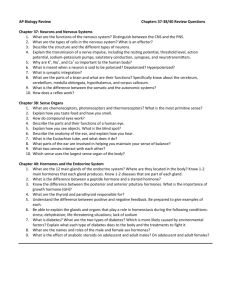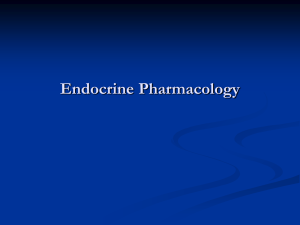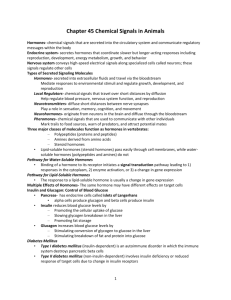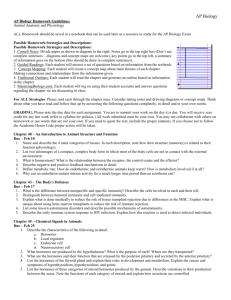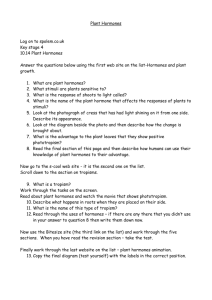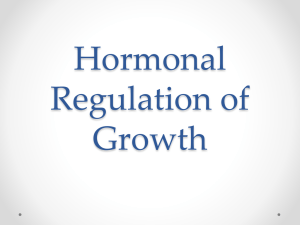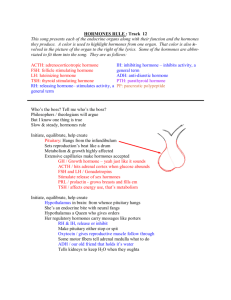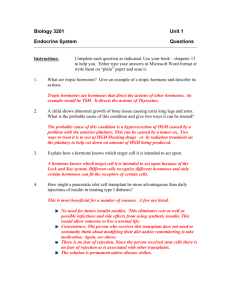Study Topics
advertisement
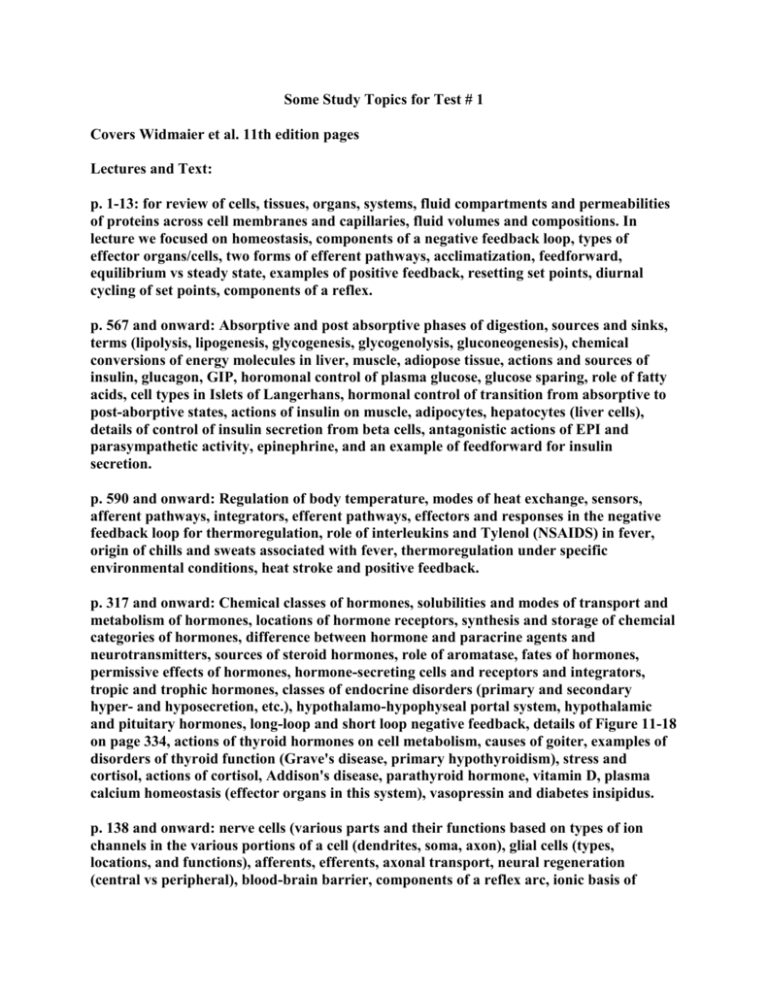
Some Study Topics for Test # 1 Covers Widmaier et al. 11th edition pages Lectures and Text: p. 1-13: for review of cells, tissues, organs, systems, fluid compartments and permeabilities of proteins across cell membranes and capillaries, fluid volumes and compositions. In lecture we focused on homeostasis, components of a negative feedback loop, types of effector organs/cells, two forms of efferent pathways, acclimatization, feedforward, equilibrium vs steady state, examples of positive feedback, resetting set points, diurnal cycling of set points, components of a reflex. p. 567 and onward: Absorptive and post absorptive phases of digestion, sources and sinks, terms (lipolysis, lipogenesis, glycogenesis, glycogenolysis, gluconeogenesis), chemical conversions of energy molecules in liver, muscle, adiopose tissue, actions and sources of insulin, glucagon, GIP, horomonal control of plasma glucose, glucose sparing, role of fatty acids, cell types in Islets of Langerhans, hormonal control of transition from absorptive to post-aborptive states, actions of insulin on muscle, adipocytes, hepatocytes (liver cells), details of control of insulin secretion from beta cells, antagonistic actions of EPI and parasympathetic activity, epinephrine, and an example of feedforward for insulin secretion. p. 590 and onward: Regulation of body temperature, modes of heat exchange, sensors, afferent pathways, integrators, efferent pathways, effectors and responses in the negative feedback loop for thermoregulation, role of interleukins and Tylenol (NSAIDS) in fever, origin of chills and sweats associated with fever, thermoregulation under specific environmental conditions, heat stroke and positive feedback. p. 317 and onward: Chemical classes of hormones, solubilities and modes of transport and metabolism of hormones, locations of hormone receptors, synthesis and storage of chemcial categories of hormones, difference between hormone and paracrine agents and neurotransmitters, sources of steroid hormones, role of aromatase, fates of hormones, permissive effects of hormones, hormone-secreting cells and receptors and integrators, tropic and trophic hormones, classes of endocrine disorders (primary and secondary hyper- and hyposecretion, etc.), hypothalamo-hypophyseal portal system, hypothalamic and pituitary hormones, long-loop and short loop negative feedback, details of Figure 11-18 on page 334, actions of thyroid hormones on cell metabolism, causes of goiter, examples of disorders of thyroid function (Grave's disease, primary hypothyroidism), stress and cortisol, actions of cortisol, Addison's disease, parathyroid hormone, vitamin D, plasma calcium homeostasis (effector organs in this system), vasopressin and diabetes insipidus. p. 138 and onward: nerve cells (various parts and their functions based on types of ion channels in the various portions of a cell (dendrites, soma, axon), glial cells (types, locations, and functions), afferents, efferents, axonal transport, neural regeneration (central vs peripheral), blood-brain barrier, components of a reflex arc, ionic basis of membrane potential, use of the Nernst equation, driving forces, effect of changing ion concentrations across the membrane on the membrane potential, electrogenic pump, graded and action potentials, phases of the action potential, properties of voltage-gated K+ and Na+ channels, threshold, types of refractory periods, action of lidocaine, action potential conduction in myelinated and non-myelinated axons, reason for unidirection conduction of action potentials, nodes of Ranvier, pathology of multiple sclerosis. Labs: Using live animals in the laboratory: role of the IACUC. Frog reflex lab: corneal reflex, wiping reflex, spinal shock, transcutaneous stimulation. Endocrine case studies lab: diabetes insipidus, primary hypothyroidism, primary adrenal insufficiency, and hypoparathyroidism. Know causes, symptoms, and treatments. Critically reading a scientific paper by King et al., 1999. Evaluating credibility of authors, institutions, sources of references. Significance of first author and senior author The peer review process (steps in the sequence, virtues and limitations) Role of the principal investigator Components of a research paper Steroid hormone synthesis and negative feedback. Interpreting results presented in tables and graphs Results of the study including effects on hormone levels and muscle strength.

